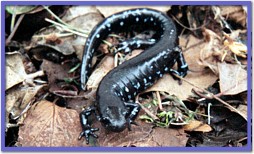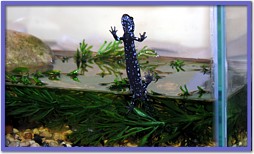
| More Biology of the Blue-spotted Salamander | (Click thumbnail images for larger photos.) |
Food
Like a lot of the other aspects of this species' biology, its food habits
aren't well known. The adults are thought to eat various arthropods and
soft bodied invertebrates such as slugs and earthworms. Reports of them eating isopods (pill bugs), land snails,
slugs and worms suggest that their main feeding grounds are below the
leaf litter in forests. Blue-spotted Salamanders that I've kept in captivity
would readily eat earthworms,
but refused to touch any insects I gave them. Other folks who've raised them have been able to get them to eat crickets.
Habits
Activity - Blue-spotted Salamanders are probably nocturnal foragers, to avoid the drying effects of the sun and daytime heat. They spend daylight hours under logs and rocks or deep under the leaf litter. At night they come out and search for worms and other invertebrates that are also more active on the forest floor at night. In spring and fall, when night-time temperatures dip down, it wouldn't surprise me to find out that they were more active during the daytime, especially on cloudy or wet days.
Defense - To look at it, you might think that a Blue-spotted Salamander would be at the mercy of many predators. Small, slow-moving, soft-bodied; how could such a critter defend itself? Actually, quite well, thank-you. Being small helps it hide under the forest litter and under logs or rocks. This species' colouration helps it hide, too. The blue spots help to break up the outline of the salamander making it quite hard to see, should it ever venture out into the open. As to being slow-moving? Well, most of the time they are, but they can scoot along when they have to. They can move surprisingly fast, when prompted by danger (or when you're trying to photograph them!) and will quickly disappear from sight under something.
They have one other trick that's a last line of defense: a wriggly tail. When a Blue-spotted Salamander is disturbed by a predator, say a bird or some small mammal looking for a tasty snack, it holds its body still and wiggles its tail back and forth. This motion, and the sound it would make for a nocturnal predator, entices the predator to strike at the tail, instead of the more vital head or body of the salamander. Gland's in the salamander's tail produce a milky, noxious liquid, that oozes out when it faces a threat. So, if a predator is persistent, it gets a mouthful of yucky tasting salamander tail, and most likely spits it out. The yucky stuff is also quite sticky and will foul the predators mouth with debris for a while, too, further distracting it from trying to eat the salamander. Two of four salamanders I caught one year had chunks missing from their tails, but were otherwise quite healthy. It would seem that this is a strategy that works.
Some authors have reported that Blue-spotted Salamanders will also adopt an aposematic display position with their tail held up and curved over their body when alarmed. Although I was never able to elicit this behaviour, this is a common technique among other toxic or noxious salamanders and newts to make sure a predators sees them and recognizes them as being distasteful before striking. That's what the term aposematic refers to. Prey animals can prevent a potentially damaging attack by being boldly coloured or acting in a way that gets them noticed, if they have some chemical defense or other special means to protect them. It's to the prey's benefit not to be attacked in the first place, and it's in the best interests of the predator not to try to eat something that's noxious or toxic. So, bold colouring and warning behaviours have evolved in species to ward off attacks, by advertising some serious protective mechanism. This is why skunks are the colour they are, and why they raise their large tails and stamp around when you get too close to them. They're giving you fair warning!
Overwintering - Blue-spotted Salamanders are not freeze tolerant, like Wood Frogs and some other frog species, so they must "hibernate" somewhere that doesn't freeze. Some authorities suggest they go down abandoned small mammal burrows or other soil openings to below the frost line and remain there over winter. However, there really isn't a lot of information about overwintering in this species. I think that this and other mole salamanders (Ambystoma spp.) don't really hibernate anyway. There are a number of anecdotal reports of people finding Blue-spotted Salamanders in their basements in January and February, suggesting that the critters are still active down below the frost line. I've kept some in the fridge over winter and whenever I opened the container to check on them they were active! Rather than truly hibernating I think they just seek out habitats below the frost line, avoid freezing and keep on being salamanders: possibly moving around and hunting invertebrates all winter.
Care in Captivity
 I've had good success keeping
Blue-spotted Salamanders in captivity for periods up to a month or
two. They're small, so you can keep them in a small aquarium. For spring-caught
individuals, I set up an aquarium that is half water-half land, or that
has a large island floating in shallow water. Early in spring the salamanders
seem to prefer to be submerged in water most of the time. They even choose
to eat under the water if given the choice. I've noticed that their preferences
change as the season progresses. Later on they spend more and more time
on the land in the aquarium, and ultimately avoid going into the water,
so long as their is a moist surface to lie on. A summer-caught salamander
should be kept in a terrarium with moist moss or gravel. If you put soil
in, it will burrow under, make a mess, and you'll never see it. They like
to hide under things, so a small cave or piece of bark in the aquarium
is a good idea. And keep a secure lid on the aquarium. Small salamanders walk
up glass like you or I climb stairs!
I've had good success keeping
Blue-spotted Salamanders in captivity for periods up to a month or
two. They're small, so you can keep them in a small aquarium. For spring-caught
individuals, I set up an aquarium that is half water-half land, or that
has a large island floating in shallow water. Early in spring the salamanders
seem to prefer to be submerged in water most of the time. They even choose
to eat under the water if given the choice. I've noticed that their preferences
change as the season progresses. Later on they spend more and more time
on the land in the aquarium, and ultimately avoid going into the water,
so long as their is a moist surface to lie on. A summer-caught salamander
should be kept in a terrarium with moist moss or gravel. If you put soil
in, it will burrow under, make a mess, and you'll never see it. They like
to hide under things, so a small cave or piece of bark in the aquarium
is a good idea. And keep a secure lid on the aquarium. Small salamanders walk
up glass like you or I climb stairs!
Worms are readily eaten by captive Blue-spotted's. I haven't been able to get them to eat any hard- bodied invertebrates or insects, but they do well on a worm a week. Store-bought crickets might be an option, smaller-sized ones would be best. Like I mentioned above some folks have been able to get them to eat crickets, but I never could.
Don't feed salamanders, or any other critter, worms that have been kept in captivity for more than a few days. There is evidence to suggest that worms are wonderful breeding grounds for toxic bacteria! Even though the worms may still appear healthy they may, in fact, have become a living lethal brew of toxins. I learned this the hard way feeding young snakes with captive worms. Always feed critters with freshly-dug garden worms. |
If you're ever lucky enough to catch some salamander larvae, they can be raised quite easily in a small aquarium. Feeding them can be a bit tricky, as they require live food. The motion of their prey is a stimulus to attack. So you have to have a source of tiny water animals: daphnia, copepods, insect larvae, etc. If you have a pond, lake or other wetland nearby, you can take a fine-meshed dip net and swirl it around to collect some of these tiny critters. Put them in a small jar and empty the contents into the aquarium. Another way of getting food items for the larvae is to take bunches of plants from a wetland and place them in the aquarium. These will usually be covered in tiny animals that the larvae will eat. Change the plants every couple of days to keep a constant supply of food available. When you notice that the larvae are beginning to lose their gills and tail fins (this can happen rapidly, once they reach at least 3 cm in length), provide them with some land: a floating piece of wood or a rock sticking out of the water. When they are finished their transformation, release them back where you got them.
As with any critter you remove from the wild, always let it go back at the same spot you found it, at an appropriate time of day. Don't release a salamander at high noon on a hot day! Wait for evening or a rainy day.
Final Thoughts
Blue-spotted salamanders are, in my opinion, incredibly beautiful little critters. They are hard to find and get hold of, but it is a worthwhile experience if you can. Their cryptic nature and nether-worldly existence makes them seem exotic, but they are probably quite common in the woodlands of southeastern Manitoba. I'm concerned about how little we know about them, and how most people don't even realize they exist. Ignorance is not bliss, it is a recipe for extinction. We need to know more about all Manitoba's wildlife, so we can ensure that future generations will still be able to marvel at amazing critters like the Blue-spotted Salamander.
Help NatureNorth produce more great articles:
Acknowledgments
Some of the information contained in this article was drawn from the following sources.
The Reptiles and Amphibians of Manitoba. 1982. William B. Preston. Pub. by the Manitoba Museum of Man and Nature. Winnipeg, Mb., Canada. ISBN 0-920704-13-1A Field Guide to the Reptiles and Amphibians of Eastern and Central North America - The Peterson Field Guide Series No. 12. 1975. Roger Conant. Pub. by Houghton Mifflin Co. Boston. ISBN 0-395- 19979-4.
Salamanders of the United States and Canada. 1998. James W. Petranka. Smithsonian Institution Press, Washington. 587 pp.
Attention all amphibian lovers!If you want to help conserve amphibians in Manitoba then get involved with the Manitoba Herps Atlas! When you find a critter enter a record to help build a province-wide database of species' locations and natural history. |
